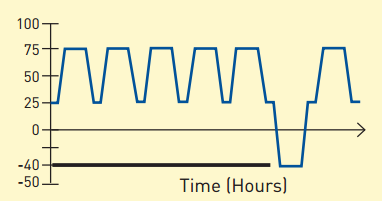The GR-1221 standard outlines the environmental and mechanical tests to ensure long term operational performance. The following section provides an overview of each of the test requirements and the importance for compliance.
Mechanical Integrity
The Mechanical Integrity category consists of three main components which are the Mechanical Shock, Vibration and Thermal Shock. These tests are designed to ensure the optical splitter performance when subjected to normal conditions during storage, transportation and installation.
Endurance
The Endurance category consists of five main components which are the High Temperature Storage (Dry), High Temperature Storage (Damp), Low Temperature Storage, Temperature Cycling and Cyclic Moisture Resistance. These tests are designed to simulate an accelerated aging effect to test the estimated lifetime of the optical splitter. The effects of moisture coupled with varying temperature levels have a degradation effect on the components within the optical splitter, especially the epoxy which provides a certain level of structural integrity to the PLC, optical fiber and the splitter housing.
Testing Method
The details of the optical performance criteria critical to a PON system is outlined in the Table below:
Mechanical Shock
Mechanical Shock testing is performed to verify that the optical splitters are not damaged when they are dropped or knocked. The splitter is mounted rigidly on a fixture at 1.8m height and dropped 8 times at each of its three perpendicular axes. This test cycle is repeated 5 times.
Vibration
In a vibration test, the products being tested are mounted to a “shaker.” By stressing the optical splitter, the test will reveal whether high frequencies of vibration induce performance change. The splitter is held on the shaker set with a sinusoidal vibration at a frequency of 10 to 2,000Hz with 1.52mm amplitude for 12 cycles where each cycle is a change from 10Hz to 2,000Hz and back in 20 minutes. This test is done for each of 3 mutually perpendicular axes.
Thermal Shock
The Thermal Shock Test is performed in a temperature chamber to verify that the optical splitters are not structurally compromised when transported from a one temperature extreme to another. The temperature chamber is heated to 100°C and the splitter is placed within the chamber. It is left to dwell at 100°C for 30 minutes, the temperature dropped to 0°C
High Temperature Storage (Dry)
The splitter is stored within a temperature chamber heated to 85°C with <40%RH for 2,000 hours for qualification and to 5,000 hours for information on the performance of the splitter. Interval testing of the optical splitter is
performed at 168, 500, 1000, 2000 and 5000 hour intervals. Insertion loss is monitored for all ports
High Temperature Storage (Damp)
The splitter is stored within a temperature chamber heated to 75°C with <90%RH for 2,000 hours for qualification and to 5,000 hours for information on the performance of the splitter. Interval testing of the optical splitter is performed at 100, 168, 500, 1000, 2000 and 5000 hour intervals. Insertion loss is monitored for all ports.
Low Temperature Storage
The splitter is stored within a temperature chamber cooled to -40°C for 2,000 hours for qualification and more than 5,000 hours for information on the performance of the splitter. Interval testing of the optical splitter is performed at 100, 168, 500, 1000, 2000 and 5000 hour intervals. The strength of the epoxy joints are tested after 2000 and 5000 hours
Temperature Cycling
The splitter is stored within a temperature chamber. For CO based splitters, the temperature range is -40°C to 70°C
For Uncontrolled environments, the temperature range is 40°C to 85°C Temperature is cycled from the extremes with a dwell time of at least 15 minutes at each of the extremes. The number of temperature cycles required is: For CO based splitters, 100 cycles for qualification, 500 for information. For Uncontrolled environments, 500 cycles for qualification, 1000 for information.
Cyclic Moisture Resistance
The splitter is stored within a temperature chamber. The temperature cycle profile is as below 85-95%RH at 75°C, RH uncontrolled at 25°C and -40°C. Dwell time at extremes is 3-16 hours. 5 cycles in total.